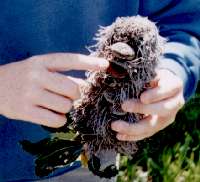|
|
Dispersal of seeds |

|
|
Dispersal of seeds |

Seeds often need to be spread far away from the "parent plant" in order for a species to survive. Sometimes the seeds are carried by the wind (as with thistles). Sometimes (as with Impatiens flowers) the seed case "explodes" when the seeds are ripe, and the tiny seeds are fired into the air so that they spread further.
Other seeds are carried inside the fruit by animals called dispersers. The animal usually feeds on the fruit, but spits out the seeds (or passes them through its digestive system). This is what happens when a bird eats a berry, flies away, and sits on a branch some distance away. Inside the bird droppings, the seed lands on the ground, and can grow into a new plant. This method of spreading seeds ensures that new plants end up far away from the "mother" plant, where they can develop without competition from the original plant.
Some seeds sprout with just water and reasonably warm temperatures. This is true of most common garden plants. Wild species usually have some kind of deeper dormancy to avoid sprouting in late summer/autumn when the seeds are dispersed. This makes sure tender seedlings are not frozen at a young age, but do not sprout until warm weather arrives in springtime.
 |
There are some special seeds, such as Australian banksia seeds, which need more than just water and warmth to sprout. Banksia seeds are in such a strong seed case that they do not sprout until a bush fire has gone through the area. The fire burns the cases, and the new plants can grow. |